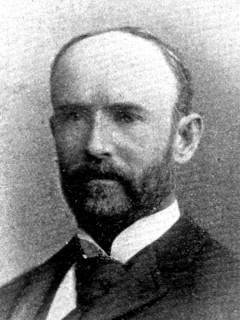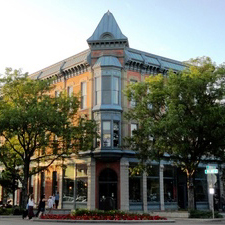News Flashbacks
Fort Collins in 1888
by Dick Baker
Triangle Review, 1974

Editor's Note: This article is part of a series of 15 articles which will trace the development of Fort Collins and Loveland through "the elegant '80s." The research was compiled by historian Dick Baker, a retired city official whose grandfather was mayor of Fort Collins.
And there was light. As of April 11th, 1888 no matter dark the night, people could go back and forth without the aid of a lantern. Only six of the 2000 candle power lights were turned on Saturday night, but by Sunday night all were ablaze with a steady and intense brilliance. These arc lights put Denver in the shade as they were 400 candle power more powerful. Not only was the power plant to produce power but it was to manufacture electrical appliances, repair same, do machine work and make brass castings. Still railroad excitement as the Union Pacific was surveying between Bellvue and Livermore. They were still displaying marble obtained from the Livermore area. The Hatch Bill was passed by Congress, which meant the start of the C S U experiment station. Their first allotment was for the sum of $15,000.
The drainage problem still confronted the city fathers. There was an area along Mountain Avenue nearly four blocks along which was constantly saturated with moisture and if the surface was not submerged the ground was covered with a crust of alkali. Citizens pointed out that this was not only unsightly but an unhealthy condition. The west side of the 100 block on South College Avenue was something of a swamp and to this day there are sump pumps in the basements of some of the building in this location. Also the area around the present city hall was bad. The solution, of course was a drain which would also serve as a sanitary sewer. This started a good old-fashioned political battle. It was estimated that it would cost $ 8,000 for a drain starting in the middle of the 300 block of West Mountain Avenue and thence along this street to Lincoln Avenue and down Lincoln to the river. A city convention was held and in the midst of the meeting the anti-sewer delegates walked out. However, in the end the 2,600 foot sewer was built. It averaged a depth of ten feet and was a 12 inch brick line with a cement bottom. Most of the opposition to the sewer was on how it was to be financed. The city finally came up with $2,000 and the cost was much less than the original estimate. An important water decision was handed down by Judge Robinson of the district court. This was the right that water for domestic purpose has precedence over all others. This effected the Larimer County ditches, (New Mercer, Pleasant Valley and Larimer County No. 2).
The new cheese factory on Riverside that local people had worked so hard to establish was reduced to ashes. The fourth of July was a quiet one this year. People were saving all their energy for the fireman's tournament which was a real "lu-lu." In the tournament there were teams from all over the state, ten in all. Fireman demonstrated great skill and dexterity in all types of races, ladder climbing and all the events that made up such a meet. The great final climax came between Loveland and Fort Collins in the horse-cart race. This was a race where men were harnessed to the cart. The team was of nine men, two pushing, and the rest pulling in harness. The race between the Loveland and Fort Collins carts was a desperate one.


Preserving the history of Fort Collins, Colorado & the Cache la Poudre region





